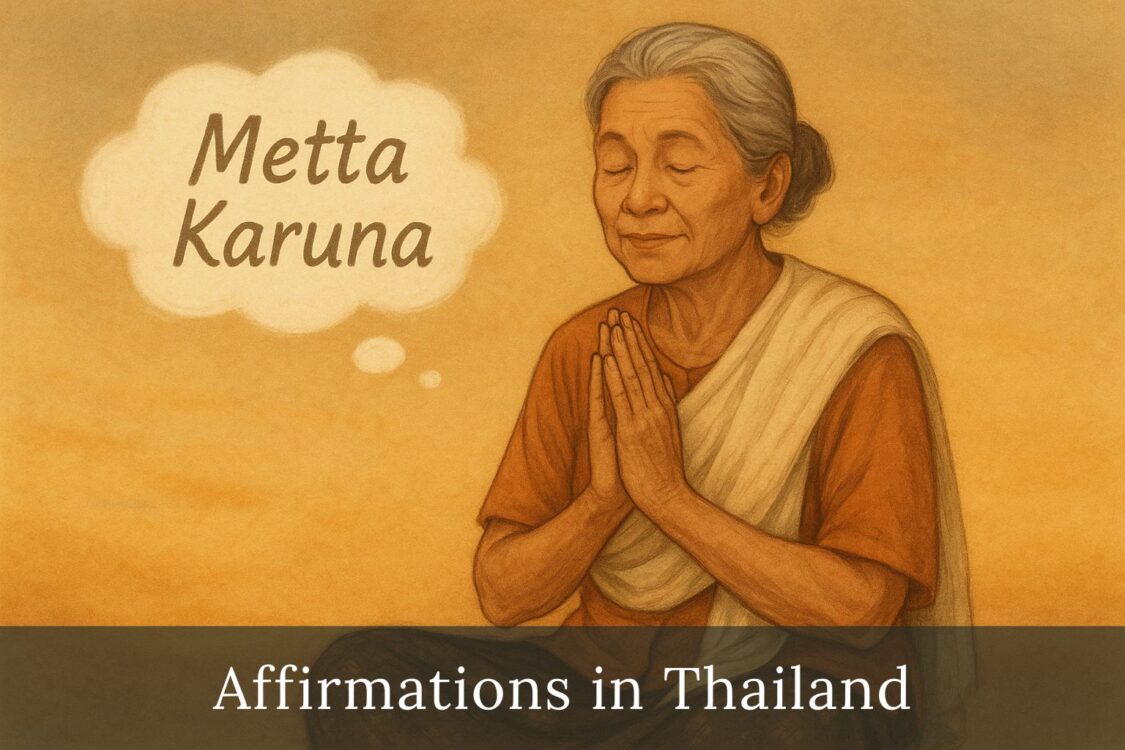Affirmations in Buddhism & Thailand

In the final chapter of my book Life Lessons from Isaan (Thailand), I share 20 powerful affirmations — short, carefully crafted sentences meant to bring light into our everyday lives. Many people think of affirmations as a Western self-help idea, something that popped up in recent decades alongside motivational quotes and personal development seminars. But in truth, the practice of using words to shape our inner world has been around for centuries — especially in Buddhism.
The Buddha once said, “All that we are is the result of what we have thought.” That one line — so short and clear — reminds us that our thoughts aren’t just passing clouds. They build who we are and become the life we live.
That’s the heart of affirmation practice. And it’s not something foreign or new to Thai culture. In fact, Thailand has had its own version of affirmations for generations: the sacred khatha (คาถา) and Buddhist chants, sometimes quietly whispered before leaving the house or lighting incense in the family prayer room. These chants aren’t just words; they’re reminders, intentions, prayers, and affirmations — spoken with faith and heart.
We often think of affirmations as short, personal statements like “I am strong” or “I choose peace.” But that is just one type. When we look closely, we can see that khatha and chants serve a similar purpose. A chant like Itipiso bhagavā arahāṁ sammāsambuddho — which describes the qualities of the Buddha — is more than praise. When someone repeats it, they’re reinforcing values: purity, enlightenment, compassion, wisdom. Saying those words, again and again, begins to shape how you see yourself, how you see the world. That’s affirmation in action.
The same goes for chants like Namō Tassa Bhagavato Arahato Sammāsambuddhassa, the traditional homage to the Buddha. It’s simple, repetitive, meditative. It centers the mind. It invites a quiet sense of reverence, of remembering what truly matters. Just like a modern affirmation might do when we say, “I am grounded. I am safe.”
Even non-canonical khatha that many Thais use in daily life serve this role. Take the maha sanay (มหาเสน่ห์) khatha, often whispered as a sacred charm for likability — it’s not just superstition. It’s a way of stepping into the day with confidence and warmth. It’s a subtle act of saying: “I am welcome in the world. I am loved.” That’s not so far from any English-language affirmation you might find in a self-help book.
In the final chapter of Life Lessons from Isaan, I describe the mind as a sim — a sacred temple space inside us, like the ordination halls you find in small Thai villages. Each thought is like a candle lit in that space. Some thoughts brighten the room. Some fade out in silence. But we choose which ones we light. And every time we repeat a chant, a khatha, or a simple affirmation — we’re lighting another candle.
Whether it’s a monk reciting Itipiso before dawn, a street vendor murmuring the maha sanay khatha before a busy market day, or a grandmother softly repeating “metta karuna” (เมตตา กรุณา), meaning loving-kindness and compassion, while cooking — these are all ways we train the mind to return to peace, strength, and goodness.
Just like affirmations, they help us focus our energy, reframe our thinking, and step back into the world with calm and confidence.

These practices are quiet and personal. In the book, I mention an Isaan nurse in a crowded hospital who took a deep breath and said to herself, “I am strong. I can help.” That one sentence — small and steady — was enough to ground her. It’s not unlike someone repeating the Itipiso chant in the back of their mind during a moment of fear. Both are calls to courage. Both are ways of remembering who we are.
I also write about a larb vendor I knew at a Thai market. She used to think her food didn’t sell because others were cheaper. That thought shaped her mood, her energy, her outlook. But one day, she changed it: “I will do my best.” It wasn’t a spell — it was a shift. A new thought, lit like a candle, and from there, the rest followed.
Affirmations — whether from a book or a Buddhist chant — aren’t just nice thoughts. They’re tools. Practices. Ways to steer the mind, gently but firmly, back toward light. Back toward truth.
You don’t have to wait for a Thai temple visit or a festival to begin. You can start while walking through the market, while folding laundry, or while eating noodles with your family. The sim of the mind never closes. And every affirmation or khatha — every word you speak to yourself — is a brick in that sacred space. You are both the one who builds it and the one who lights it.
This last chapter of Life Lessons from Isaan, then, is not just about affirmations. It’s about recognizing the sacred weight of our thoughts. About seeing old chants and modern phrases as part of the same lineage of human intention. It’s about choosing, every day, to light one more candle.
- Affirmations in Buddhism & Thailand - June 7, 2025
- Speak Thai Naturally Without the Gymnastics - April 20, 2025
- The Best Learn Thai Podcast and YouTube Channel - April 10, 2025




